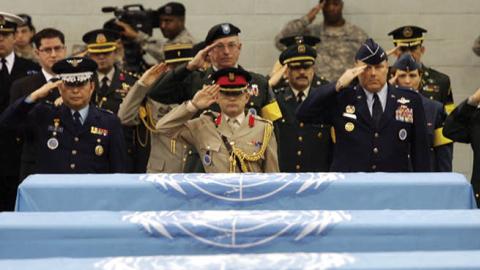The Moon Jae-in Administration, despite most South Koreans not supporting this position, has been lobbying the US to declare a formal end to the Korean War and to sign a “peace treaty” with North Korea, without North Korea reducing its threats or complying with the existing armistice. Such a declaration is hasty and dangerous. One of the key issues during the armistice negotiations was the prisoner of war (POW) issue. This essay will focus on the need for accountability and the return of POWs and missing personnel from the Korean War as well as those abducted by North Korea.
The Korean War began when North Korea, under Kim Il-sung, attacked South Korea on June 25, 1950, with the permission of the USSR’s Joseph Stalin and China’s Mao Zedong. The UN quickly passed a resolution to defend South Korea from communist aggression, and the UN Command, led by the US, was formed. Sixteen Sending States sent combat forces to the UN Command, and more countries sent additional support to defend the Republic of Korea (ROK) or South Korea.
Initially, well equipped with Soviet-supplied tanks and weapons, North Korea’s Korean People’s Army (KPA) almost overran all of South Korea, pushing the UN forces to the Busan Perimeter in the southeast corner of the Korean peninsula. After the successful amphibious Marine landing in Incheon on September 15, 1950, the UN forces advanced northward almost to the Yalu River, on the border with China. By November, China sent poorly equipped but numerous armed Chinese—the so-called Chinese Volunteer Force—to Korea, pushing the UN forces back. Ceasefire began when an armistice was signed on July 27, 1953 by the military representatives of the UN Command on one side and the KPA and Chinese Volunteer Force on the other side.
A major issue on the agenda during the armistice talks was the POW exchange. The negotiating parties agreed to exchange a list of the names of POWs first. The UN Command provided 132,000 names, which include some 20,000 Chinese. The communist side (China and North Korea) provided only 11,559 names (ROK: 7,142, US: 3,198, UK: 919, other Sending States: 300), which was a gross undercount, shocking and outraging the American public.
Admiral C. Turner Joy, in his book How Communists Negotiate, wrote that in the earlier part of the war, North Korean and Chinese communists captured about 100,000 UN Command POWs, and they even claimed that they captured 65,000 UN soldiers, as they bragged on their propaganda radio broadcast during the early part of the war. So 11,559 was a major understatement and revealed their intention of not returning the majority of POWs.
The official US figure for missing personnel (MIA) at that time was 11,224 and for South Korea, it was about 82,000. The UN Commission of Inquiry’s report on human rights in North Korea shows the ROK POW estimate to be 50,000-70,000, far higher than the 7,142 that North Korea provided.
If the North Korean figures are to be believed, more than 8,000 American troops and about 73,000 South Korean soldiers died after they were captured. But is it the case? What happened to over 70% (8,000/11,224) of missing American troops and almost 90% (73,000/82,000) of missing South Korean soldiers, not to mention other UN MIAs?
Certainly, many POWs did die in the hands of North Koreans and Chinese during the Korean War, and the atrocities are recorded in Philip Chinnery’s book Korean Atrocity! Forgotten War Crimes 1950-1953 as well as in war crimes records of the US government. For instance, the Korean War Crimes case number 75 (KWC 75) describes numerous American soldiers losing their lives during the “death march” from Seoul to Pyongyang from September 26 to October 10, 1950 due to starvation, lack of medical care, beatings, and summary executions by the North Korean military. Of 376 men, only 296 survived in this instance. In another war crimes case, this time by the Chinese (KWC 113), a lieutenant survivor described what he witnessed on November 8, 1950: the Chinese took his wounded men, hung them up by their hands, and set their clothes on fire, and when they became unconscious or died, stuck bayonets and sticks into their eyes. Even assuming some died in battles with their remains unrecovered, it is highly unlikely that such a large percentage died by the time the list of POW names was exchanged.
The explanation for this discrepancy is simple: North Korea did not return the majority of POWs. Chinnery writes that some POWs, such as F-86 pilots, were handed over to the Soviet military as soon as they were captured for intelligence purposes, and after that, they were sent to gulags for hard labor or used for chemical, biological, and nuclear weapons testing. Some of the POWs were sent to China. For instance, a compound with two camps in China held about 900 non-Korean POWs, mostly from the US, the UK, and Turkey. The majority of POWs languished and suffered in camps in North Korea.
According to the US Defense POW/MIA Accountability Agency, 7,554 US military personnel are still missing from the Korean War, after the return of some of the POWs’ remains. In the case of the ROK POWs, North Korea returned only 8,300 as part of a POW exchange. That means North Korea did not return about 42,000-74,000 ROK POWs. Those POWs were forced into the North Korean military during the war, and after the armistice, forced into hard labor in mines. According to the ROK Ministry of Defense estimate, about 500 ROK POWs are believed to be still alive in North Korea.
An ROK soldier, Yoo Young-bok, who was captured by the KPA in June 1953, escaped from North Korea after 47 years of hard labor working in mines. He is one of over 80 ROK POWs who escaped from North Korea to South Korea. The majority of them have since passed away, and there were about 11 remaining in South Korea as of March 2021. Yoo said some of the ROK POWs were absorbed into construction units within North Korea’s Department of Interior and sent to work in mines. There were nine construction units with 400-600 in each unit, which would equate to as many as 5,400 ROK POWs. He and other POWs working in harsh mine conditions believed that they would not be forgotten, that their country would bring them back. That was not to be.
In addition to the POWs, North Korea abducted over 80,000 ROK civilians during the war, forcing many of them into the North Korean military or using them for the skills that North Korea lacked after it purged the “class enemies” from its own ranks of skilled personnel. The Korean War Abductees Research Institute has compiled the names of 112,625 South Koreans whom North Korea abducted prior to the armistice and afterward. North Korea also abducted Japanese citizens, especially in the 1970s and 1980s, and the Japanese government has been demanding their return. Since the Korean War is technically not over, all these kidnappings are war crimes. During the armistice negotiations, North Korea denied there were any civilian abductees. None taken during the 1950-53 period were returned after the armistice was signed.
Before any discussions about an end of war declaration, the matters of the UN POWs and the civilians abducted by North Korea should be resolved. These are unfinished issues of the armistice and the Korean War. Families still await to see their loved ones if they are alive, and want closure if they are deceased. The POWs and abductees deserve to be remembered.



















